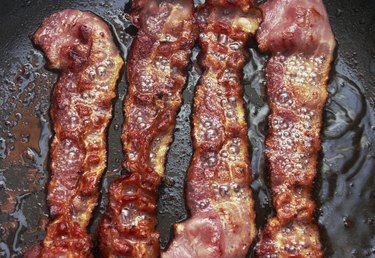
You have to treat bacon as just another cut of meat if you want to cook it to soft, chewy tenderness. Think of a thick ribeye steak, for example. If you cook it over high heat, you'll crisp the meat and partially melt the fat, leaving it slightly warm and rubbery. If you cook it at a lower heat, however, and let the fat render and coat each morsel, you'll have a tender but toothsome, moist steak. The same goes with bacon. You have to cook bacon slow and low to get the meat fully cooked yet soft and chewy.
Oven
Video of the Day
Step 1
Take the bacon out of the refrigerator and separate the slices on a plate. If you have slab bacon, slice the bacon into 1/4-inch-thick slices.
Video of the Day
Step 2
Heat the oven to 275 degrees Fahrenheit. Bring a saucepan of water to a boil and pour the water into an oven-safe bowl or shallow dish. Carefully place the water on the floor of the oven.
Step 3
Place a wire rack in a baking dish or roasting pan. Season the bacon slices with freshly ground black pepper, if desired, and lay them flat on the rack, spaced about 1/2 inch apart. Place the pan in the oven.
Step 4
Roast thin bacon slices for 10 minutes and turn them over with tongs. Roast the bacon an additional 10 to 15 minutes and slide the oven rack out to check the bacon.
If you have thick-sliced bacon, roast it for 20 minutes then turn it over with tongs. Roast the bacon another 20 to 25 minutes and slide the oven rack out to check the bacon.
Step 5
Examine the fat on the bacon and the color of the meat. Soft, chewy bacon has most of the fat rendered out of it, so it only has very thin streaks of white outlining the meat and running through it. The color should resemble dark mahogany. You can also taste the bacon to check the chewiness.
If the bacon still has large pockets or flaps of fat and a light color, slide the oven rack back in and continue roasting it in 10-minute increments and checking it until it reaches the desired consistency.
Step 6
Take the pan out of the oven and transfer the bacon slices to a plate lined with paper towels. Blot the tops of the bacon slices with paper towels and serve as soon as possible.
Step 7
Pour the rendered bacon fat though a cheesecloth-lines sieve and into a heat-proof container or bowl. Cover the rendered bacon fat and store it in the refrigerator.
Stovetop
Step 1
Take the bacon out of the refrigerator and separate the slices. If cooking slab bacon, slice it 1/4 inch thick. Pour a couple tablespoons of water in a cast-iron skillet or other heavy-bottomed pan placed on the stove.
Step 2
Place the bacon slices in the skillet, spacing each about 1/2 inch apart. Season the bacon with freshly ground black pepper, if desired, and set the heat to medium-low.
Step 3
Cook thin-sliced bacon for about 10 minutes and drain the rendered fat from the pan into a heat-proof bowl or container. Return the pan to the stove and turn the bacon slices over.
If cooking thick-sliced bacon, cook it for 15 minutes before draining the fat and turning it over.
Step 4
Cook the bacon until the fat render from it, leaving only thin streaks. Drain the bacon fat from the pan every 10 minutes. The meat should have a dark mahogany color. The exact cooking time varies depending on how much fat the bacon has and how thick it is, but expect about 15 to 20 minutes total cooking time for thin-sliced bacon and 35 minutes total cooking time for thick-sliced bacon.
Things You'll Need
Roasting pan
Wire rack
Cast-iron skillet or other heavy-bottomed pan
Tip
Select bacon with almost as much meat as fat for best results.
Buy slab bacon if possible and have the butcher slice it for you or slice it yourself. It's easier to cook thick-cut bacon soft and chewy than it is thinly sliced bacon.